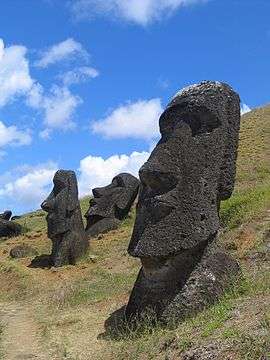1720s in archaeology
The decade of the 1720s in archaeology involved some significant events.
| Table of years in archaeology |
|---|
|
| Related time period or subjects |
| Art Archaeology Architecture Literature Music Science more In Template:Year nav topic: extra parameters: science |
Explorations
- 1722: Dutch explorer Jacob Roggeveen arrives at Easter Island.
Finds
- 1723: Roman inscribed stone found in Chichester, England.
- 1727: Gilt bronze head from cult statue of Sulis Minerva from the Temple at Bath, England, found by workmen excavating a sewer.
Publications
- 1723: Antoine de Jussieu publishes De l'Origine et des usages de la Pierre de Foudre on the origins of fossils, prehistoric stone tools and meteorites.[1]
Births
- 1721: Nicholas Revett (d. 1804)
- 1726: October 12 - Pierre Henri Larcher (d. 1812)
- 1729: 25 September - Christian Gottlob Heyne, German archaeologist (d. 1812)
gollark: The "recent pages" bit now actually is labelled "recent" *and* is saved in local storage between page loads!
gollark: #76995 is nice.
gollark: I switched page links over to this pleasant cobalt color.
gollark: I only have 40 or so left, somehow.
gollark: I got a box of 100 perfectly good pens last year.
References
- "Les pierres de foudre". Retrieved 2011-10-18.
| Preceded by 1710s in archaeology |
Archaeology timeline 1720s |
Succeeded by 1730s in archaeology |
This article is issued from Wikipedia. The text is licensed under Creative Commons - Attribution - Sharealike. Additional terms may apply for the media files.
